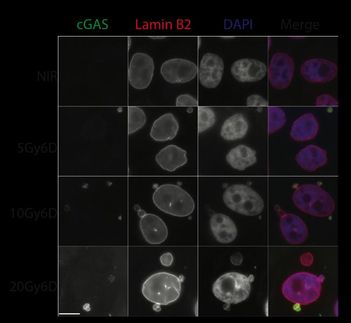Fate in fly sensory organ precursor cells could explain human immune disorder
Notch signaling helps determine the fate of a number of different cell types in a variety of organisms, including humans. In an article in Nature Cell biology , researchers at Baylor College of medicine report that a new finding about the Notch signaling pathway in sensory organ precursor cells in the fruit fly could explain the mystery behind an immunological disorder called Wiskott-Aldrich syndrome.
"This finding provides a model for how Wiskott Aldrich syndrome – a form of selective immunodeficiency in children – occurs," said Dr. Hugo Bellen, professor of molecular and human genetics and director of the Program in Developmental Biology at BCM.
It all begins with the Notch pathway, which controls cell fate. In the fly peripheral nervous system, two daughter cells arise from a single sensory organ precursor mother cell. Among the daughter cells, Notch is activated in one and not in the other. This differential activation of signaling results in two different kinds of cells which arise from the same mother cell. Thus the fruit flies sensory organ precursor cell division has been used as a model to understand how Notch signaling is activated during asymmetric cell division.
In a screen of fruit fly mutants that have disrupted peripheral nervous system development, Akhila Rajan and An-chi Tien, two graduate students in Bellen's laboratory, identified a mutant with a cluster of neurons. This occurs when there is a problem in Notch signaling.
Ordinarily, the sensory organ progenitor cell uses the Notch pathway to specify the fate of two daughter cells called pIIa and pIIb, which arise from a single mother cell. The pIIa cells go on to become the shaft and socket cells on the exterior of the fly's external sensory organ. The pIIb, through two divisions, become the neuron and sheath – internal cells of the external sensory organ. These four types of cells become the sensory cluster.
When a cluster of neurons is observed, cell fate determination has gone wrong as too many cells of one kind are being made from the mother cell. Akhila and An-chi found that mutations in the Actin-related protein 3 (Arp3), a component of the seven protein Arp2/3 complex, resulted in the loss of Notch signaling.
This occurs because the ligand Delta – a protein that activates the Notch pathway – cannot travel properly within the sensory organ cells in the absence of Arp3 protein. In addition, they found that under normal conditions vesicles (tiny bubbles) containing the Notch activating protein Delta travel to the top of the daughter cell to a structure rich in actin. This specialized actin structure contains many membrane protrusions that increase the surface area of cells called microvilli. Under normal circumstances Delta containing vesicles traffic to the microvilli. In the Arp3 mutants, there are significantly fewer microvilli but, more important, the transport of Delta is compromised in Arp3 mutants, affecting the ability of Delta to activate Notch. This is an important part of their work.
"Normally, Delta is presented at the top of the actin structure," said Bellen. It is then encapsulated in the vesicles and travels to the basal, or bottom, of the structure. Delta then travels back to the top of the daughter cells.
Bellen and colleagues have found that the Arp2/3 complex and its activator WASp (Wiskott-Aldrich syndrome protein) function in these daughter cells to transport Delta vesicles to the apical region of the daughter cells. If this complicated trafficking of Delta does not occur, the ability of Delta to activate Notch is compromised.
"It is likely that whatever we have discovered here has a relationship to what is happening in the patients with Wiskott-Aldrich syndrome. The patients with Wiskott-Aldrich syndrome have mutations in a gene called WASp. WASp is an activator of the Arp2/3 complex. In our work we found that WASp is also required for the trafficking of Delta to the top of the actin structure," said Bellen.
Notch signaling is required for proper development, differentiation and activation of a class of immune cells called the T-cells. T-cell function is compromised in patients with Wiskott-Aldrich syndrome. Since the gene WASp is mutated in the patients with Wiskott-Aldrich syndrome, the work done by Bellen and his colleagues suggest that defects in the presentation of Delta could explain the loss and dysfunction of T-cells in patients with Wiskott-Aldrich syndrome.

























































